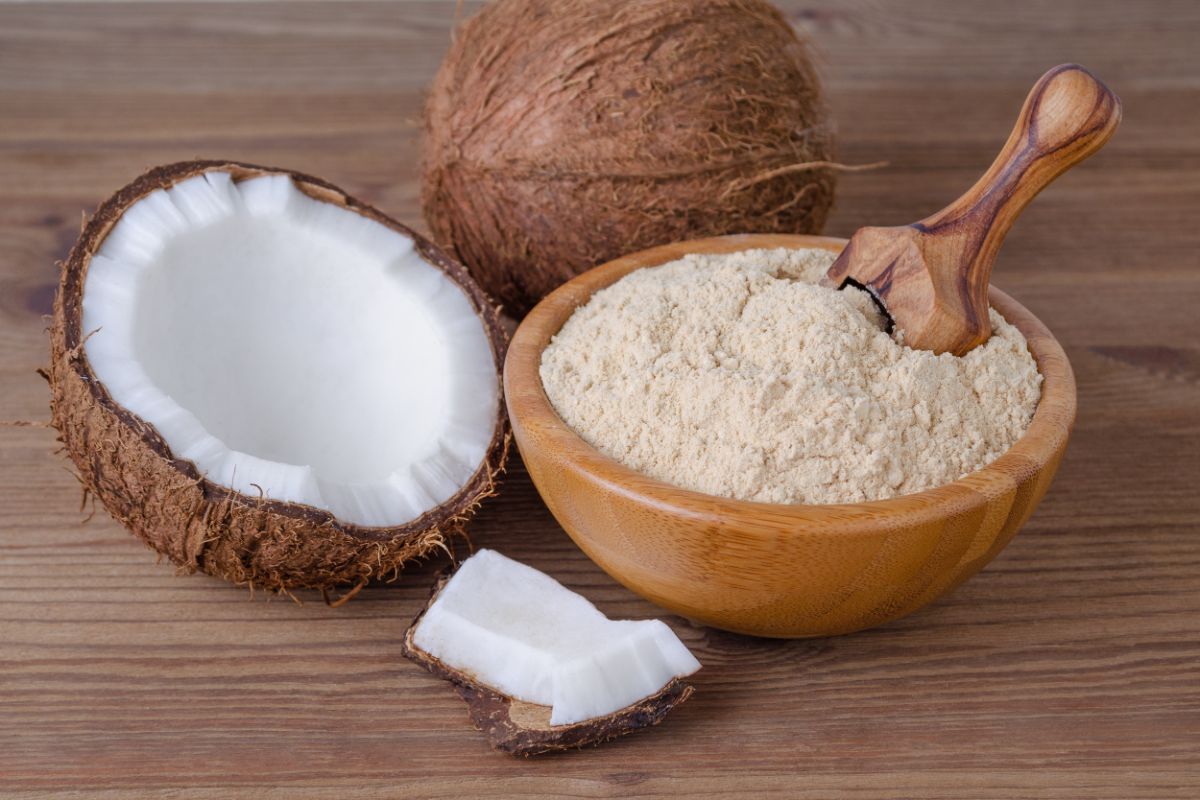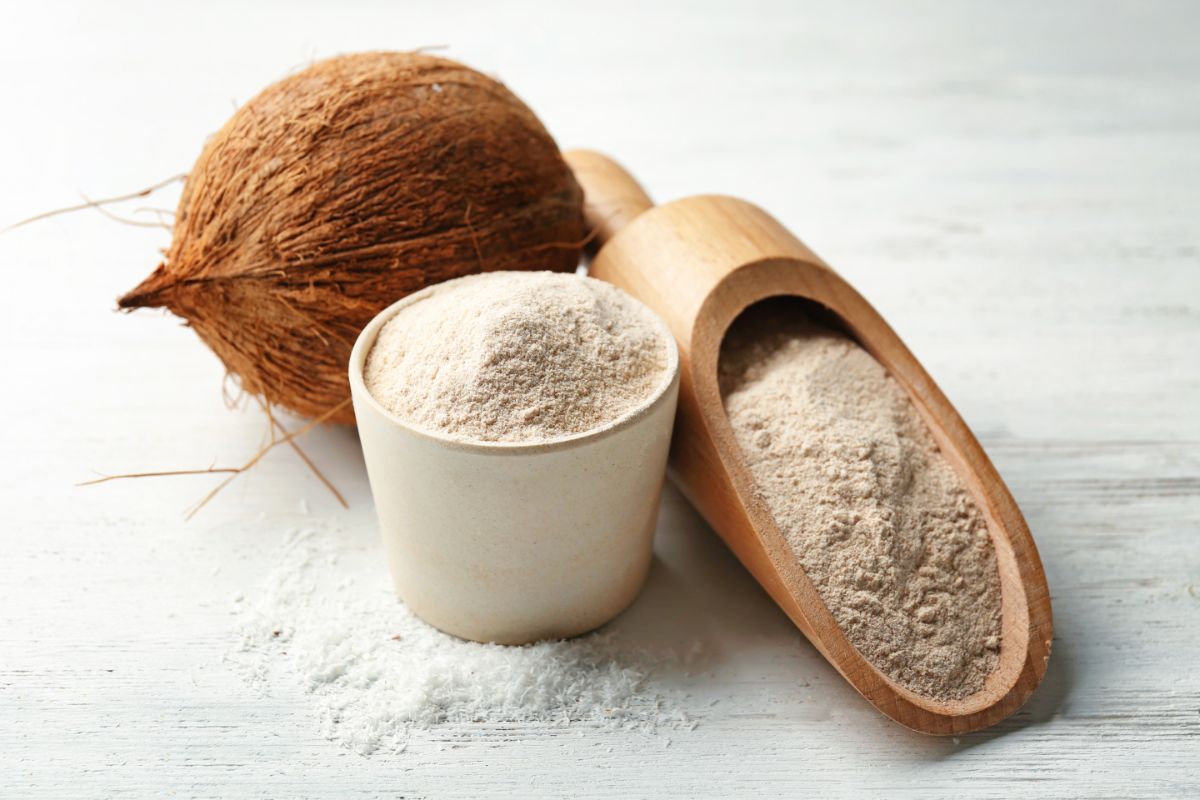Coconut flour is a little healthier than white flour. However, it is a far healthier choice for many who have to avoid white flour for a variety of reasons. Coconut flour also offers a few benefits over other alternatives to white flour.

What are the health benefits of coconut flour?
Coconut flour is low carb. This makes it a great choice for those on a keto diet or trying to watch their blood sugar. It promotes blood sugar stability. Coconut flour has an incredibly low glycemic index, making it a safe food for those with blood sugar problems.
It is also high in fiber despite being gluten-free. Coconut flour is grain-free, making it suitable for those on a grain-free diet.
Coconut flour comes with all the healthy fats you find in coconuts. It provides plant-based iron, something appreciated by vegetarians and vegans who otherwise struggle to avoid anemia.
It provides medium-chain triglycerides linked to improved brain and heart health. These healthy fats can lower your bad cholesterol. The medium-chain triglycerides are also better for your heart over the long run.
They may be mostly saturated, but they aren’t harmful the way butter and margarine are.
The lauric acid in coconut flour may kill the bacteria that cause plaque in your arteries, lowering your risk of heart disease. However, this hasn’t been proven conclusively.
There are people who claim that the lauric acid in coconut flour fights bacteria, yeast, and viruses. However, we can’t recommend eating coconut flour to fight infections.
That’s despite its history in Indian medicine as a treatment for lice, urinary problems, and viral infections.
The MCTs in coconut flour are less likely to be stored by the body as fat because the proteins are broken down for energy instead. Now you’re less likely to get a gut because you eat a lot of baked goods.
Some people think this leads to faster burning metabolism, though that isn’t proven.
The fermentable and soluble fibers in coconut flour are thought to be good for the good gut bacteria. This may reduce the inflammation and symptoms linked to irritable bowel syndrome.
The combination of fiber and protein helps reduce hunger and appetite. This is nearly the opposite effect seen when eating white flour. This means you could actually lose weight when replacing white flour with coconut flour.
Coconut flour has two to three times as much fiber as other gluten-free flour.
It is as low in fat as chickpea flour and amaranth flour.
However, it has less protein than chickpea and almost flour. It is similar in protein content to hazelnut flour, but hazelnut flour is dangerous if you have a known nut allergy. It has far fewer omega-three fatty acids. Coconut flour has fewer calories than almond flour, too.
What are the health benefits of white flour?
White flour often contains added nutrients like iron, calcium, and folate. This can offset the nutritional deficits in the modern diet. White flour is easily digested by the body.
While the modern diet is lacking in fiber, not everyone can eat whole grain flour. In contrast, coconut flour contains three times as much fiber as whole wheat flour and ten times that of all-purpose flour.
Coconut flour may leave you running to the bathroom from the heavy dose of fiber. The simple preparation of white flour recipes makes it much easier to bake with.
When is coconut flour a better choice than white flour?

Coconut flour is safe if you have celiac disease. It is safe if you have a wheat allergy. More importantly, coconut flour will not cause problems for those who are allergic to a variety of foods.
Coconut flour is incredibly safe for people who can’t eat other wheat flour alternatives. For example, almond flour is not an option if you’re allergic to tree nuts. If you can’t eat gluten or tree nuts, coconut flour is one of the few options available to you.
Understand that coconut flour is not a cure-all. For example, coconut flour doesn’t contain all of the essential amino acids you need the way quinoa does. When you make these substitutions, consider how else you may need to alter your diet to get all the nutrients you need.
How is coconut flour made?
Coconut flour comes from coconut flesh that was dried and ground. It was a byproduct of coconut milk harvesting. Note that coconut milk is a decent alternative to dairy milk.
The coconut meat is scraped out, washed, grated and strained. This separates the solids from the liquids. The liquids may go into coconut “milk” while the solid mass is dried and ground into flour. The white powder looks like wheat flour.
It feels similar, too. Another point in favor of coconut flavor is that it has a very mild taste. In comparison, anything made with brown rice has an intense aftertaste. You’ll even taste it in rice-based ice cream alternatives.
How can you add coconut flour to your recipes?
Coconut flour will absorb more liquids than white flour. This is why you cannot replace one cup of wheat flour with one cup of coconut flour. You can substitute a quarter cup of coconut flour for a cup of all-purpose flour.
You should add an extra quarter cup of water to the recipe as well. You may need to add an extra egg to the recipe as well since coconut flour doesn’t bind as well as white flour.
Suppose you add coconut flour with extra water and eggs to the white flour recipe. The end result should have a similar texture to traditional recipes. This is true whether making bread, pizza crusts, or wraps.
Coconut flour is notable for being suitable for other flour substitutions. For example, its mild and relatively lack of flavor means you can use it to thicken soups and stews. You can use it to bread other foods like chicken fingers.
And coconut flour can be used as a binder in vegetarian loaf recipes. This makes coconut flour unique since it is equally suitable for meatloaf and tofurkey. That’s one reason why coconut flour is so popular with vegetarians.
